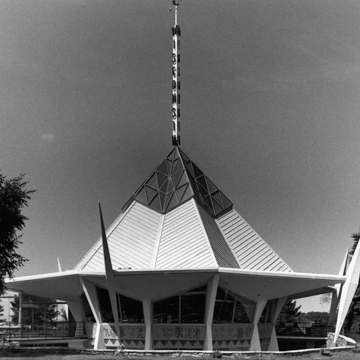The Wisconsin Pavilion originally stood at the heart of the New York World’s Fair of 1964–1965, a two-year celebration of the future, as viewed through the lens of the mid-1960s. Wisconsin has few better examples of mid-twentieth century popular art than this building. Steinman of Monticello designed Wisconsin’s rotunda building in a futuristic style that might be called “Jetsonesque,” after the Space Age cartoon series popular at the time. The roof, whose design is based on the geometry of the triangle, dominates the structure visually. Triangles of lapped steel siding form a twelve-faceted pyramid, which rises sixty feet to terminate in an angular skylight. The skylight’s triangular stained glass panes are tinted in a W pattern of gold and blue. At the base of the pyramid, six star-shaped canopies encircle the building, each supported on piers shaped like stacked triangles and by finlike gold pylons. The entire spiky composition culminates in a soaring fifty-foot mast, its metal letters spelling out wisconsin. Steinman’s triangular geometry intended to evoke the future, but at the same time the tipi-like roof suggested Wisconsin’s Indian past—or at least the popular fallacy that all Indians once lived in tipis. The Native American theme continued in the low walls beneath the windows, where tile mosaics showed stereotypical Indians dancing atop inverted triangles.
Pruden Steel Buildings of Evansville constructed the building as the entrance rotunda for a larger U-shaped structure that housed exhibits promoting the state’s agricultural and industrial products and scenic attractions. The display’s highlight was “The World’s Largest Cheese,” a 171/4-ton chunk of the state’s most famous product. During the World’s Fair, some thirteen million people visited the Wisconsin Pavilion. After the fair, the Wisconsin exhibit was dismantled, and the cheese was cut up and sold at a charity auction in Eau Claire. Ivan Wilcox, a Boscobel blacksmith, saved the pavilion from demolition. Central Wisconsin Broadcasting subsequently bought it and reconstructed it here to house a radio station. It also continues to promote Wisconsin’s dairy products through the quirky medium of kitsch. Visit the Wisconsin Pavilion to find a cardboard replica of “The World’s Largest Cheese” and meet “The World’s Largest Talking Cow” and her much smaller (and less talkative) calf. Press a button, and Chatty Belle (the cow) will tell you the benefits of eating 100 percent natural Wisconsin cheese.















